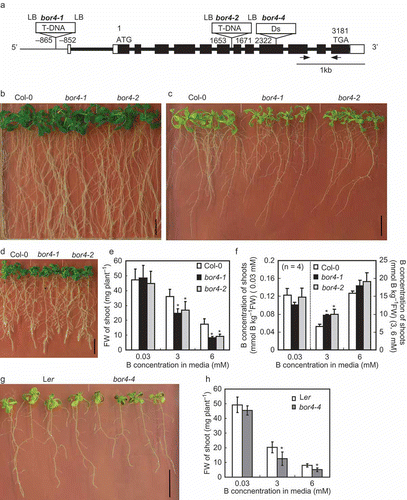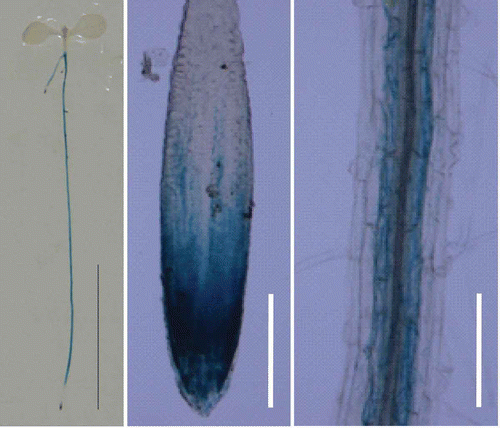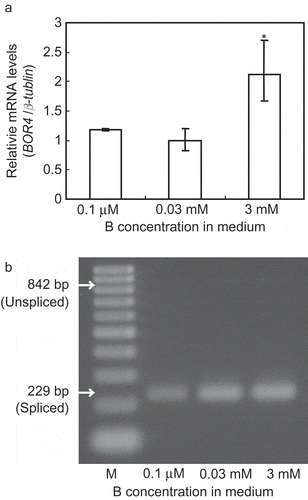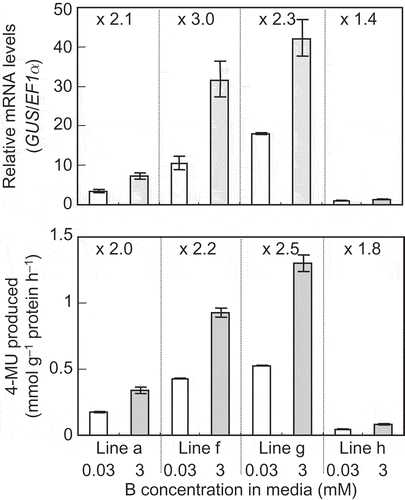Figures & data
Figure 1 Growth characteristics of Arabidopsis thaliana mutants of BOR4. (a) The exon-intron structures of the BOR4 gene, and schematic representation of insertions of T-DNA in bor4-1, bor4-2 and Ds transposon in bor4-4. Filled boxes, open boxes and thick bars indicate exons encoding a protein, untranslated regions (UTR) and introns, respectively. The arrows indicate the position of the primers for real-time polymerase chain reaction (PCR). (b–d) Growth of wild type Col-0 plants, bor4-1 and bor4-2 under 0.03 mM (b), 6 mM (c), and 0.1 µM (d) boric acid supply. Four-day-old plants grown under 0.03 mM boric acid were transferred to the media containing 0.1 µM, 0.03 mM and 6 mM boric acid and then they were incubated for 14 d. Bars show 10 mm. (e, f) Fresh weights (e) and boron (B) concentrations (f) of aerial portions of bor4-1 and bor4-2. Four-day-old plants grown under 0.03 mM boric acid were transferred to the media containing 0.03, 3 and 6 mM boric acid and then they were incubated for 14 d. Means ± standard deviation (SD) are shown (n = 7–8 for fresh weight, n = 4 for B concentrations). Asterisks show a significant difference compared to wild type Col-0 under the same condition (Student’s t-test, p < 0.05). (g) Growth of wild type Ler plants and bor4-4 under 6 mM boric acid supply. Four-day-old plants grown under 0.03 mM boric acid were transferred to the media containing 6 mM boric acid and then they were incubated for 14 d. A bar shows 10 mm. (h) Fresh weights of aerial portions of bor4-4. Four-day-old plants grown under 0.03 mM boric acid were transferred to the media containing 0.03, 3 and 6 mM boric acid and then they were incubated for 14 d. Means ± SD are shown (n = 8). Asterisks indicate a significant difference compared to wild type Ler under the same condition (Student’s t-test, p < 0.05). FW, fresh weight.

Figure 2 GUS histochemical staining of the transgenic Arabidopsis thaliana expressing β-glucuronidase (GUS) under the control of the BOR4 promoter. Transgenic plants were grown in the media containing 0.03 mM boric acid for 7 d. GUS histochemical staining of a whole plant (left), root tip (middle) and root hair zone (right) are shown. Bars show 10 mm (left) and 100 µm (middle and right), respectively.

Figure 3 Changes of BOR4 transcript levels in roots after high boron (B) treatment. Arabidopsis thaliana wild type Col-0 plants were grown in the solid media supplemented with 0.03 mM boric acid for 8 d. Then the plants were transferred to the media containing 0.1 µM, 0.03 mM and 3 mM boric acid, incubated for 3 d and RNA was extracted from roots. (a) Quantification of BOR4 mRNA levels. BOR4 transcript levels were standardized by the levels of β-tublin. The values shown are those relative to the mean value at 0.03 mM boric acid, which was defined as 1. Means ± standard deviation (SD) are shown (n = 3, from independent plant materials). An asterisk shows a significant difference compared to the values at 0.03 mM boric acid (Student’s t-test, p < 0.05). (b) Splicing of the first intron of BOR4 transcripts. cDNA was amplified with the primers corresponding to the exon1 and exon3-exon2. The size of the spliced and unspliced product is expected to be 229 and 842 bp, respectively. 100 bp ladder DNA size marker is shown on the left lane as M.

Figure 4 Response of β-glucuronidase (GUS) mRNA and GUS activity in the transgenic Arabidopsis thaliana expressing GUS under the control of the BOR4 promoter upon high boron (B) treatment. Four independent transgenic A. thaliana lines carrying ProBOR4-GUS (Lines a, f, g and h) were first grown in the solid media containing 0.03 mM boric acid for 7 d, and were transferred to the media supplied with 0.03 or 3 mM boric acid. Then they were incubated for 3 d, and mRNA levels of the GUS gene and GUS activities were determined in the roots. mRNA levels of GUS were standardized by the levels of elongation factor 1α transcript. The values shown are those relative to the mean value of Line h under 0.03 mM boric acid, which was defined as 1. GUS activities are shown as production of 4-MU (mmol g−1 protein h−1). Means ± standard deviation (SD) are shown (n = 3, three measurements). Fold changes of mRNA levels or GUS activities under 3 mM boric acid relative to those under 0.03 mM boric acid are shown above the bars in the graph.

